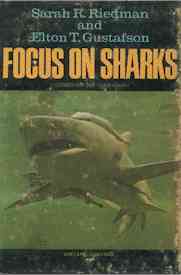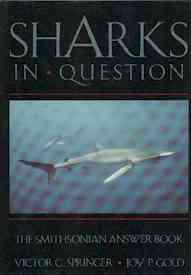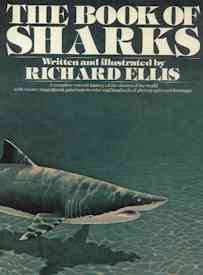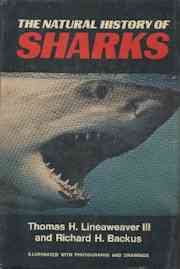10 Favorite Shark Books of All Time
As a shark biologist, I rely heavily on technical papers and scholarly
books to expand my knowledge base and contextualize my experiences in the
laboratory and field. Although I greatly enjoy learning new things, especially if I can
apply them to this or that research project, many technical works are -
truth be told - not all that much fun to read for their own sake.
Over the years, however, I have discovered a number of nicely written
books that are a joy to re-read or just to browse through, dipping in
casually here or there as something catches one's attention. Rediscovering
these books is a bit like visiting with a long-lost friend. Suddenly, one
is transported back to an earlier time in life only to find that the book
hasn't changed, the reader has. Some books I formerly thought brilliantly
original now seem trite or derivative. But a precious few manage to remain
fun to re-read and rediscover year after year.
Below are capsule reviews of my 10 favorite shark books of all time.
Winnowing down my 350 or so shark books to just these 10 favorites was
highly subjective and far from easy (which is why the list of my Top Ten
includes 20 titles!). It was difficult to separate my
enthusiasm for the most useful books from the simpler, subtler joy of a
pleasant read. The books selected here are generally not the most useful
of shark books, but they are the ones that I most enjoy re-reading to this
day.
Happy reading.
10 Honorable Mentions (just too good to leave out):
Sharks, by Henry B. Bigelow and William C. Schroeder.
1948. Chapter 3 In Fishes of the Western North
Atlantic, Vol. 1: Lancelets, Cyclostomes, and Sharks.
Sears Foundation for Marine Research, Yale University, New Haven.
pp 53-576.
Following the obligatory review of each species' taxonomic history and
morphological characters is a wonderfully eclectic narrative that often
features weird and wonderful anecdotal material you just can't find
anywhere else. Out-of-Print
The Lady and the Sharks, by Eugenie Clark. 1969. Harper
& Row, New York. 269 pp.
A wonderfully personal account of Clark's experiences managing the Cape
Haze Marine Laboratory and some of her pioneering shark research.
Nicely written, always fascinating, and often downright inspiring.
Out-of-Print
Great White Shark, by Richard Ellis and John E.
McCosker. 1991. Harper Collins/Stanford University Press,
Stanford. 270 pp.
A splendid overview of the natural and human history of the White Shark,
with a heavy emphasis on the long, complex and often bloody relationship
between Carcharodon carcharias and Homo sapiens.
Beautifully written and lavishly illustrated with photos by Al Giddings
and others.
Blue Meridian: The Search for the Great White Shark, by
Peter Mattheissen. 1971. Random House, New York. 204
pp.
Insider's view of the tale of how film-maker Peter Gimbel traveled the
globe in search of the White Shark for his feature film. Some
absolutely glorious writing that describes the awesome presence of the
White Shark and the hardships of making a documentary at sea.
Harpoon at a Venture, by Gavin Maxwell. 1952. Rupert
Hart-Davis, London . 272 pp.
A rousing personal account of Maxwell's years as a commercial Basking
Shark fisherman off Scotland, including some wonderfully evocative
writing and fascinating Appendices in which the author discusses the
Basking Shark's role in 'sea monster' mythology and disagrees with
several pronouncements of the leading Basking Shark researchers of the
day. Out-of-Print
Sharks and Rays of Australian Seas, by David G. Stead.
1963. Angus & Robertson, Sydney. 211 pp.
A splendid compilation of personal observation and anecdote about this
region's rich elasmobranch fauna - includes a now-classic account of a
ghostly white, 100+ foot shark that some believe might have been a
living megalodon (Yeah, right.). Fun stuff. Out-of-Print
Shark: a Photographer's Story, by Jeremy
Stafford-Deitsch. 1987. Sierra Club Books, San
Francisco. 200 pp.
A highly personal account of traveling the globe in search of sharks to
photograph, punctuated by absolutely gorgeous images of sharks in the
wild. As his beautifully lit and composed photos show, Stafford-Deitch
is the Karsh of Sharks, but his text reveals that he is also a fine and
observant marine naturalist.
Whale Sharks: the Giants of Ningaloo Reef, by Goeff
Taylor. 1994. Angus & Robertson, Sydney. 176 pp.
A wonderfully personal synopsis of the author's field research off
Exmouth, Western Australia, combined with a summary of what is known
about the life history of the Whale Shark and considerable background on
Ningaloo Reef. Illustrated in color with the author's excellent
underwater photographs. Out-of-Print
Great Shark Stories, edited by Ron & Valerie Taylor
with Peter Goadby. 1978. Collins, London. 329 pp.
A terrific anthology drawn from contributing authors' personal
experiences, classic and not-so-classic literature, and even
scientific reports. Idiosyncratic in both style and content, but great
fun. Re-released under the title, Great Shark Writings.
The Fishes of Australia: Part 1, The Sharks, Rays, Devil-Fish,
and Other Primitive Fishes of Australia and New Zealand, by
Gilbert Percy Whitley. 1940. Royal Zoological Society of New South
Wales, Sydney. 280 pp.
A taxonomic nightmare, but mixed among the confused science is a great
deal of weird and wonderful anecdotal material from the Austral region
that one simply cannot find anywhere else. Fascinating! Out-of-Print
|
 10 10
Focus on Sharks, by Sarah H. Riedman
and Elton T. Gustafson. 1969. Abelard-Schuman, New York. 256 pp.
Originally written for young adults, this book does an admirable job
summarizing much of then-recent scientific findings about sharks,
presenting a great deal of material in crisp, clear prose. Although
some of the material is rather dated, this book conveys the
excitement and challenge of the early days of doing shark research
and places the discoveries in the larger contexts of paleontology,
zoology, medicine, commerce, and public safety. The authors skillfully
balance depth and breadth of their treatment in a way that is rarely
matched in more recent shark books. Well illustrated with over 100
black-and-white photos and drawings that complement the text nicely.
Out-of-Print
[Top] |
|
 9 9
About Sharks and Shark Attack, by
David H. Davies. 1964. Hobbs, Dorman & Co., New York. 237 pp.
Although the focus of this book is rather heavily on shark attacks,
the material on shark biology and research is exceptionally clear
and detailed. Davies skillfully summarizes basic shark biology and
translates into clear, accessible prose much then cutting-edge
research conducted by himself and his colleagues at the
Oceanographic Research Institute in Durban, South Africa. This
research includes work on keeping sharks in captivity, shark growth
rates and migration, measuring shark heart rates, testing sharks'
hearing and reaction to electrical stimuli. There is also a chapter
dedicated to providing brief answers to common questions about
sharks and shark attacks. The book is illustrated with over 60
black-and-white photos, many showing aspects of shark anatomy and
pioneering research methods rarely seen elsewhere. It's tough to
find a copy nowadays, but well worth the effort. Out-of-Print
[Top] |
|
 8 8
Sharks: an Inquiry into Biology, Behavior,
Fisheries and Use, edited by Sid Cook. 1987. Oregon State
University Extension Service, Portland. 237 pp.
Containing the collected papers of talks presented at a shark
conference held at Oregon State University during October 1985, this
book features aspects of shark-human interaction not found in other
symposium volumes. For example, there are papers on the significance
of sharks in human psychology and the role of sharks - and shark
experts - in the media. There are also papers on the ecological role
of sharks in marine communities, human impacts on shark populations
(with special reference to neotropical freshwater sharks and
sawfishes), the forensic study of shark attacks, fisheries and use
of deep-sea sharks in Japan, and an absolutely terrific review of
shark behavior. Although some of the papers are illustrated with
black-and-white figures, production values of the overall volume are
rather low - perhaps to keep costs down and help make the book
available for its very modest pricetag. But there can be no question
that this collection of papers is among the most diverse and
interesting of symposium volumes.
[Top]
|
|
 7 7
Tigers of the Sea: Hawaii's Deadly Sharks,
by Jim Borg. 1993. Mutual Publishing, Honolulu. 88 pp.
Documenting the social, economic, political, and ecological
repercussions of a spate of recent Tiger Shark attacks in Hawaiian
waters, this book explores - better than anything I have read to
date - the many, complex facets of how different community interests
can collide over what to do about 'dangerous' sharks. Local
fishermen advocated catching as many big Tiger Sharks as possible in
the hope of removing the attacking individual(s), while influential
native Hawaiian families insisted that Tiger Sharks hold a special
spiritual significance for them and that killing them is
unacceptable. In between these opposing groups are politicians who
simply want to keep the public peace and marine biologists who
attest that Tiger Sharks typically move huge distances between
islands and that any attacking shark is probably many miles away. A
few photos of the major players in the story are included. But it is
the diversity of facts and opinions revealed as the story unfolds
that is utterly fascinating.
[Top] |
|
 6 6
Myth and Maneater: the Story of the Shark,
by David Kenyon Webster. 1962. W.W. Norton and Co., New York. 223
pp.
This is a grossly underappreciated book. Although superficially it
doesn't look too impressive, it is very nicely written and - on
careful reading - it contains a great deal of original information
not found anywhere else. The reason for this originality owes much
to the fact that the author corresponded with an incredible
diversity of people from all over the globe having some manner of
professional interest in sharks: scientists in Norway, fisheries
officers in the Philippines, military personnel in Japan, divers in
New Zealand, information officers in India, surfers in South Africa,
lifeguards in Hawaii, ministers of natural resources in Fiji, and
chambers of commerce in Florida. As a result, this book contains a
rich variety of facts, theories, anecdotes, and perspectives that
gives an unusually balanced account of the complex relationship
between man and shark. An insert of black-and-white photos includes
some interesting and unusual images. If I have one criticism about
this book it's that it lacks an index, which makes it difficult to
find a particular neat fact or account. But the book is so well
written, it's a pleasure to re-discover other fascinating tidbits
while trying to locate the one(s) sought. Out-of-Print
[Top] |
|
 5 5
Sharks in Question: the Smithsonian Answer
Book, by Victor G. Springer and Joy P. Gold. 1989.
Smithsonian Institution Press, Washington D.C. 187 pp.
Arranged in an attractive, logically-sequenced Question-and-Answer
format, this book is terrific as a quick reference or just great fun
to browse through. The answers are concise but fairly comprehensive,
written in clear, non-condescending prose, and feature multiple
references to the primary literature for those who wish to pursue a
matter beyond the scope of the book. The authors are at their most
enjoyable when speculating, cautiously, about questions for which
science has not yet determined a clear-cut answer. The appendices
feature a handy table listing the maximum known sizes of selected
sharks and an annotated classification listing the 368 species of
sharks known at the time of printing. Illustrated with over 100
black-and-white photographs and drawings plus an insert of color
plates which, together, show many species and aspects of research
methodology that usually don't make it into popular shark books. An
excellent index and bibliography add greatly to the book's value as
a reference. One caveat, however: the spine of the soft-bound
edition has a disconcerting tendency to split, causing the color
plates to fall out; this problem does not occur in the hard-bound
edition.
[Top] |
|
 4 4
Sharks of Polynesia, by Richard H. Johnson. 1978.
Les Editions du Pacifique, Papeete. 170 pp.
One of the best books about shark behavior ever written. Johnson,
who worked closely with Donald Nelson on several shark research
projects, nicely summarizes shark sensory biology and general
patterns of shark behavior, provides an identification guide to the
17 most commonly encountered sharks of the central Pacific, reviews
the life history of each, and then draws heavily on his own
experience to describe their disposition and behavior patterns.
Includes many exciting accounts of the author's personal
experiences, much detailed first-hand information about shark
behavior, and stunning underwater photographs - many by Johnson. A
terrific, highly informative read. Re-released under the
title, Sharks of Tropical and Temperate Seas.
[Top] |
|
 3 3
Shadows in the Sea: the Sharks, Skates and
Rays, by Harold W. McCormick, Tom Allen, and Captain William
Young. 1963. Sidgwick and
Jackson, London. 415 pp.
This is one of the most consistently surprising shark books ever
written. The science is very dated, but there's so much fascinating
material on strange fishing stories, exotic myths and legends from
far-flung parts of the South Seas, bizarre historical coincidences,
and much, much more, that it simply doesn't matter. The book also
includes a wonderful survey of chondrichthyan diversity, seasoning
straight-forward natural history with strange tales of interaction
of these fishes with humans. As a result, the book reads more like
Ripley's Believe it or Not or a Medieval bestiary than a serious
reference, but all the quaint tales seem to be drawn from fairly
reputable sources, such as newspapers and official government
documents. A great source of tidbits to spice up any shark-related
article or cocktail party story. Well illustrated with over 100
black-and-white photos and drawings. Slightly-updated and
re-released under the same title, but with Allen listed as the sole
author.
[Top] |
|
 2 2
The Book of Sharks, by Richard Ellis.
1976. Grosset and Dunlap, New York. 320 pp.
This is probably the most popular shark book ever published and the
reasons are not hard to fathom. Featuring 20 full-color
reproductions of the author's attractive paintings, over 150
black-and-white photos, paintings, and drawings, and passionate -
often poetic - text, this book is deservedly still in print and
selling well. Ellis writes with an endearing and unabashed
enthusiasm, seeming very and sincerely eager to share all the neat
stuff he has learned about sharks. Although the text has been
somewhat revised in subsequent printings, I prefer the first edition
above all others. Almost a third of first edition consists of
detailed and fascinating profiles of "Shark People",
diverse individuals who - in one way or another - are professionally
involved with sharks; this section has been greatly reduced in
subsequent editions. Another feature of the first edition I miss
from later editions is an appendix on notes about the color plates,
in which Ellis explains something of what he was trying to convey in
each painting. In text and paintings, Ellis' passion and enthusiasm is evident on
every page, making this book a sheer delight every time. First
Edition Out-of-Print
[Top] |
|
 1 1
The Natural History of Sharks, by
Thomas H. Lineaweaver III and Richard H. Backus. 1970. Lippincott,
New York. 256 pp.
Even after more than a dozen re-readings, this remains my absolute,
hands-down favorite shark book. Not only has much of the book's
science held up reasonably well, but it is also packed full of
strange historical and literary tidbits and extremely well written.
Its authors are, respectively, a professional writer (With a name
like that, what else would he be?) and a marine biologist with the
Woods Hole Oceanographic Institution who has actually done some
significant shark research (notably on hearing in elasmobranchs and
on the life history of the Oceanic Whitetip Shark). So the book is
both highly accurate and exceptionally well written. But perhaps my
favorite aspect of this book is how clearly the authors' shared
fascination for sharks is evident on every page. It is well
illustrated with black-and-white photos and drawings, including
several classic figures from Garman's 1913 masterwork, The
Plagiostoma. The Bibliography is broken down by geographical region
and the Appendix includes the Greek derivation of scientific names
used throughout the text. The Index is detailed and well organized,
enhancing this book's value as a reference. For all these reasons,
and more, this book is a delight every time I re-read it.
[Top] |
|
To Purchase
Any of These Books:
Most of these are out of print and have been for many
years. To locate a copy for your personal library, try:
www.abebooks.com
www.addall.com
www.bibliofind.com
|










